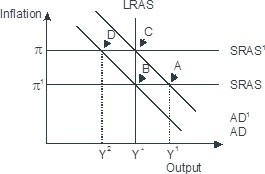George Davis and Michael Wohlgenant estimate that for every 1 percent increase in the price of Christmas trees, quantity demanded falls by 0.6 percent. The demand for Christmas trees is:
A. unit elastic.
B. inelastic.
C. perfectly inelastic.
D. elastic.
Answer: B
You might also like to view...
Based on the figure below. Starting from long-run equilibrium at point C, a tax increase that decreases aggregate demand from AD1 to AD will lead to a short-run equilibrium at point ________ and eventually to a long-run equilibrium at point ________, if left to self-correcting tendencies.
A. D; C B. D; B C. A; B D. B; C
To calculate the price elasticity of demand we divide
A) the average price by the average quantity demanded. B) the percentage change in quantity demanded by the percentage change in price. C) rise by the run. D) the percentage change in price by the percentage change in quantity demanded.
The major problem with using rabbits as money is the problem of
a. homogeneity b. divisibility c. portability d. durability e. scarcity or abundance
Which of the following statements is correct?
a. Approximately 50 percent of our national income is allocated to human capital, while the remaining 50 percent is allocated to physical capital in the form of rents, interest, and corporate profits. b. As union membership as a share of the U.S. labor force has declined during the last three decades, the share of national income allocated to physical capital has risen. c. Unions have consistently opposed minimum wage legislation because it tends to cause unemployment. d. During the past several decades, the share of output going to capital has been virtually constant, even though union membership as a share of the labor force has decreased.